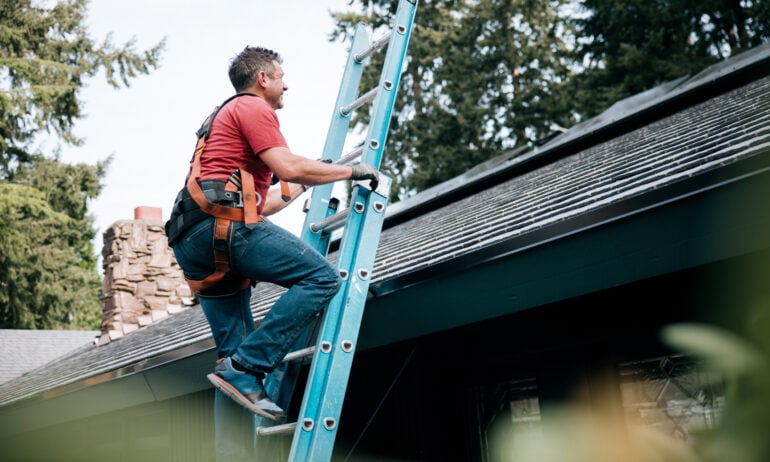Metal Roof vs. Asphalt Shingles: Cost, Lifespan and Installation
Shingle roofs are generally less expensive and easier to install than metal roofs, but metal roofs are more durable and last much longer.

Some or all of the mortgage lenders featured on our site are advertising partners of NerdWallet, but this does not influence our evaluations, lender star ratings or the order in which lenders are listed on the page. Our opinions are our own. Here is a list of our partners.
Shingle roofs are generally less expensive and easier to install than metal roofs. However, they require more maintenance and don’t last as long.
Metal roofs are a great investment for those who can afford the upfront expense, but shingle roofs may be a better choice for those with limited budgets. Climate, roof pitch and energy efficiency can also influence your decision between roof types.
Deciding factors
Material | Metal | Asphalt |
|---|---|---|
Cost | $4 to $30 per square foot. | $1.50 to $6.00 per square foot. |
Lifespan | 40 to 80 years. | 20 to 30 years. |
Installation | Difficult to install, repair and replace. | Easy to install and repair. |
Maintenance | More durable, but vulnerable to dents and oil-canning (wrinkles, bubbles or waves). | Requires more frequent maintenance, especially in warm and wet climates. |
Energy efficiency | More energy efficient. Can also be made from recycled materials and is recyclable. | Less energy efficient. |
Access | May not be permitted by some HOAs. | Generally accepted by HOAs. |
Weather resistance | More resistant to fire, wind, rain and hail, insects, rodents or rotting, but can be noisy during rain or hail. | More vulnerable to wind, rain, hail, mold, mildew and insects. |
Metal roofs
Metal roofs are highly durable and long-lasting, though they’re more expensive than shingle roofs and may not be permitted by some HOAs.
Cost
The cost of a metal roof typically ranges between $4 and $30 per square foot. About 60% of the cost is for the labor involved in installation. What you’ll actually pay depends on a number of factors, including:
Roof size. The larger your roof, the higher your cost will be.
Roof pitch. A steeper pitch will be more expensive because extra safety equipment is required for installation. Steeply pitched metal roofs can be very slippery and require snow guards or snow rails.
Location. Metal roofs cost significantly more in areas such as California and New York than they do in other locations, including Ohio, Georgia and Texas.
Roofing material. Some roof metals, such as copper and lead, generally have a significantly higher cost than others, including tin and aluminum.
Thickness of metal roofing. The thicker the gauge of the metal roofing material, the higher the cost.
Decking repairs. If your existing decking is rotten or moldy, you’ll pay about $2 to $5 per square foot of decking that’s replaced.
Permit. A permit isn’t always required to install your metal roof, but it can run between $250 and $500.
» MORE: Is a metal roof worth the cost?
Maintenance
Metal roofs are easy to clean and require minimal preventative maintenance, but their paint can chip, so they should be recoated every few years. It’s also wise to wash metal roofs with a hose periodically and carefully inspect them after storms. Metal roof repairs typically cost around $1,800 on average.
Energy efficiency
Metal roofs are naturally energy-efficient, but you’ll save more on your energy bills if you consider your local climate before making your choice.
For warmer climates: Pre-painted metal roofs reflect the sun’s rays rather than absorbing them. Roof reflectivity helps keep your home cooler, reducing the need for air conditioning.
For colder climates: Unpainted metal roofs absorb more of the sun’s warmth, keeping your house warmer and reducing the need for heating fuel.
» MORE: How solar shingles work
Safety
Most metal roofing materials are non-combustible, resistant to embers and sparks and earn high fire ratings. Metal roofs are also highly resistant to storms, wind and hail, though they are vulnerable to denting from hail.
HELOC & Home Equity Loans from our partners

on FourLeaf Federal Credit Union
670
$1,000,000
on FourLeaf Federal Credit Union

on Achieve
Achieve
4.0
NerdWallet rating
4.0
NerdWallet rating600
$300,000
on Achieve
Asphalt shingle roofs
Cost
Shingle roofs typically cost between $1.50 and $6.00 per square foot, with labor accounting for approximately 60% of the total cost. What you’ll actually pay for a shingle roof depends on a number of factors, including:
Roof size. The larger your roof is, the higher your total costs will be.
Type of shingles. Architectural or luxury asphalt shingles are more expensive than common 3-tab asphalt shingles.
Location. Some areas, such as California, New York and Pennsylvania, have higher shingle roof costs than other areas, including Georgia and Michigan.
Condition of roof decking. If any of your existing roof decking is damaged due to water or rot, replacing those damaged sections will cost you an additional $2 to $5 per square foot.
Removal of old shingles. If your old shingles need to be removed, expect to pay between $1 and $5 per square foot for the additional labor.
Permit. If you’re required to get a permit for your shingle roof installation, it will typically cost between $50 and $300.
Maintenance
To maintain a shingle roof, schedule regular inspection of shingles, chimneys, skylights and all other roof components. Keep nearby trees pruned and remove any moss or algae that turns up. Asphalt shingle roof repairs cost an average of $975.
Energy efficiency
Shingles typically have a lower energy efficiency than metal roofs because they absorb heat rather than reflect it. While this can be a plus in cold climates, it makes cooling a home in hot climates more expensive.
The darker the color of your shingles, the more heat they absorb. “Cooling roof shingles” are designed to reflect heat and can be a better fit for homes in warm climates.
Safety
Shingle roofs aren’t as resistant to extreme storms, wind and hail as metal roofs are. However, although asphalt shingles are not naturally fireproof like metal, you can still find options with high fire resistance.
Check the fire safety rating of any shingles you’re considering and opt for shingles that are rated Class A (the highest rating for fire safety). Asphalt-fiberglass composition shingles, for example, typically carry a Class A rating.
Alternative roof materials
Asphalt shingles or metal roofing may not be the right fit for your budget, aesthetic or location. Here are a few other roofing materials to consider:
Slate: Naturally fireproof, resistant to rain and snow, environmentally friendly and can last more than a century. However, slate requires additional support due to its weight, may crack under extreme temperature changes or mishandling, and is very expensive.
Clay shingles: More expensive than asphalt, but they provide more insulation in cold climates to help reduce heating expenses. Clay shingles also typically earn a Class A fire rating, making them an excellent choice for those living in areas prone to wildfires.
Synthetic slate or composite: Offers a similar appearance to natural slate tiles at a significantly lower price point. Many manufacturers use recycled materials to create their composite tiles, making them a more eco-friendly choice. However, composite isn’t fireproof and is not recommended for use in extreme weather conditions.
Green roofing: Highly eco-friendly. Green roofs incorporate a substrate and live vegetation on top of a waterproofing membrane over your roof decking. Vegetation may include moss, herbs or other low-growing, drought-tolerant plants. While these roofs can help reduce stormwater runoff and sudden-surge runoff, they can also become very heavy when soaked with rainwater, so you’ll likely need structural reinforcements for your home.







